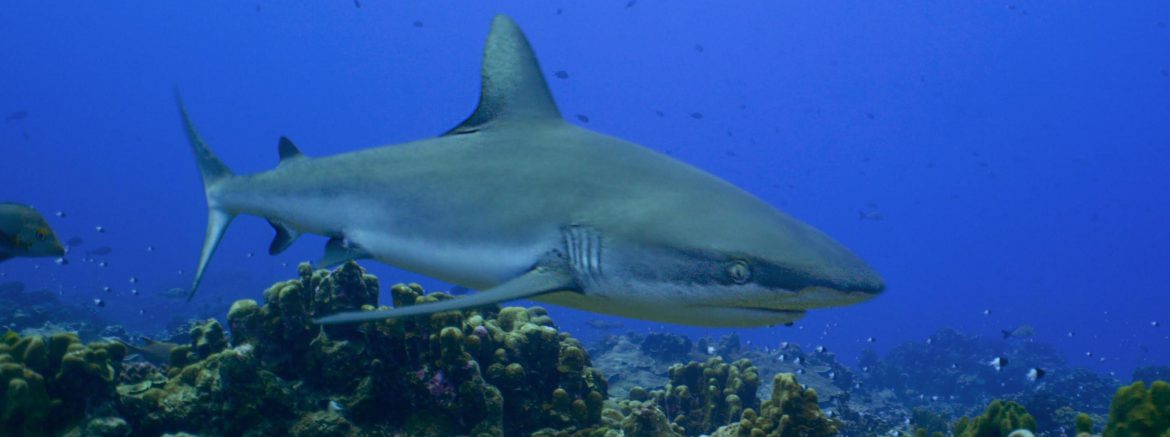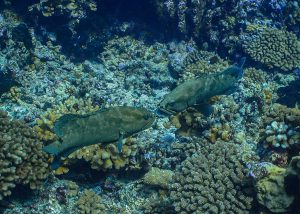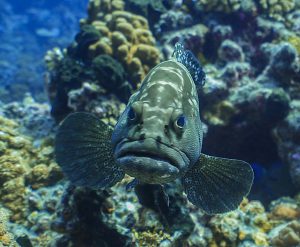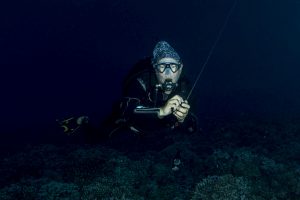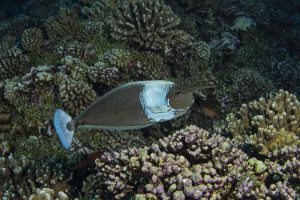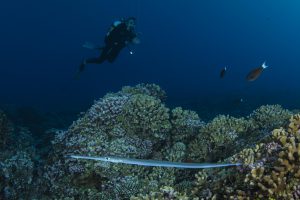Fakarava South Pass
If you come on board you’ll see that diving is clearly a passion for us (and beer). Much of our precious boat real estate is taken up by gear. For instance, our extra sails sleep in their own stateroom because their sail locker is filled with dive compressors. There is dive gear or dive related items in every room of our boat. We sail to dive! So enter Fakarava. We choose to go to Fakarava from Kauehi simply because it was in the right spot. It is close to (say 1/2 day sail) and downwind from Kauehi, and the right direction to go to Tahiti next. And, a primary concern, it has an easy-wide north pass. I am retrospectively shocked that I had never known about Fakarava. I see it now in many of my social media feeds, like one of National Geographic’s best pics of 2018. Turns out, it is one of the world’s best shark diving spots! Fakarava delivered. Here is a video of just ONE south-pass dive:
But Where Does the Dinghy Go?
We liked diving Fakarava South Pass (Tumakohua Pass) on our own. You can only get to South Fakarava by boat, and to dive there on our own we needed to secure our dinghy somewhere we could get to. We tried many options including one epic fail. The epic fail was early on when we were still trying to get the lay of the land. For this one we used a mooring ball that is in the pass itself. The big-boat mooring balls are free and French Polynesia encourages their use. This mooring ball, apparently, was private. When we returned to our dinghy after our dive it was gone. Not a panic situation since we were close enough to get to shore, but a five-star oh sh*t moment. I had tied the knot securing the dinghy and I immediately I began to doubt my knot tying ability. Once we fully surfaced, a local dive operator in his boat came by and pointed out where our dinghy was; tied to a big dive boat in front of the south pass dive operation. We deduced that the bowline I had tied must have come loose and someone was nice enough to retrieve our dinghy for us. It was a long way from the mooring ball position we were at, but the dive operator was our hero for the day. He took us on board and got us back to our dinghy. We were so grateful. Blissfully unaware and many days later, we decided to use that mooring ball again. And this time when we surfaced the dinghy was there, but a local boat operator zipped round to let us know we weren’t to use that ball. He made his point quite loudly. It really was our bad for not going to the locals and finding out what was ok or not. Lesson learned and final deduction was our dinghy was moved the first time. My knot tying ability was vindicated.
There are sharks here?
Mooring ball option expired, we tried anchoring. We did this a couple of times. It involved a long gear-laden walk in shallow water where much coral needed to be navigated around. It must have been an old shark feeding spot because upon returning from our dive, the dinghy was surrounded. There is a dichotomy between below surface and above surface shark encounters. Below surface we are at ease. Just short of being one with the sharks – they are doing their normal shark things and we avidly watch. At the surface, we are the proverbial fish out of water. BC, weights, and dive tank that were weightless moments before are now decidedly not. In the knee-high water, movement is slow, awkward and unbalanced. The sharks surrounding the dinghy behave like they are waiting for a handout. Could we be mistaken for food? Probably not, but let’s try another way.
Dive Buddies…Anyone?
So third option: we tried towing the dinghy while we were diving (you can see us holding the towing line in the pictures). This option was ok, we did it a couple of times, but definatley not as fun as diving “hands free” or “hands for camera” in CJ’s case. When we go back we will look into using the outside-the-pass mooring balls, or diving from our big boat (dive scootering), or perhaps we could make some friends who will switch off dinghy watches/dive times with us? We have already met several who would be interested if we are there when they are. Whether from a few miles or a few hundred miles ago (or sometimes even a previous ocean), it is always fun to see boats we recognize. Reconnecting with friends who are dive buddies; even better! Who’s with us?

